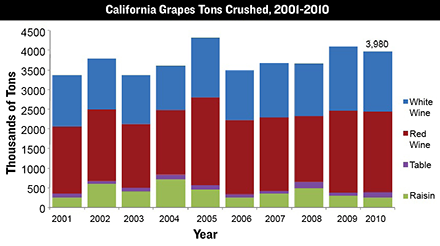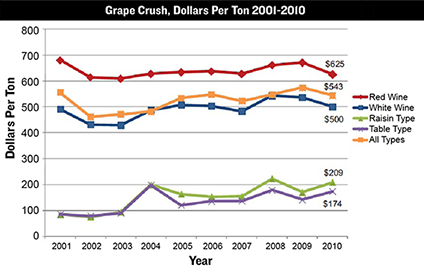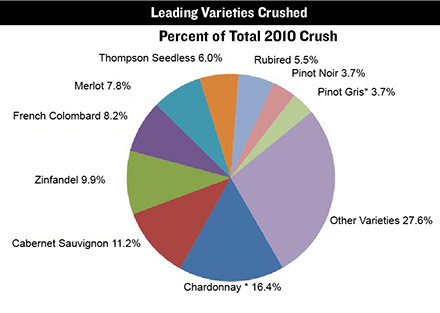Growers 'Shocked' by Harvest Report
California defies expectations with 3.6 million tons of winegrapes crushed

Sacramento, Calif.—The 2010 Grape Crush Report was issued at noon today by the California Department of Food and Agriculture, and it surprised most observers.
“I’m shocked,” said Nat DiBuduo, president of the large grower cooperative Allied Grape Growers, who found the total much higher than he anticipated and had forecast at the recent Unified Wine & Grape Symposium.
The 2010 crush totaled 3,980,229 tons, down 3% from the 2009 crush of 4,095,297 tons, according to the report. The winegrape portion was 3.6 million tons (the balance raisin and table varieties crushed). DiBuduo had forecast it would below 3.2 tons.
John Ciatti of the Ciatti Co. brokerage also was surprised. “We’ve obviously had two back-to-back harvests that were bigger than the industry expected.” He points out that the state had encouraged this, earlier downgrading its early estimate from 3.4 to 3.3 million tons.
Ciatti feels that the southern San Joaquin Valley was especially productive. “The only area that was down a lot was Lodi,” he says, adding that the crop would be even bigger, particularly in coastal areas, if it weren’t for the unfavorable weather conditions.
“Think of what it would have been if it weren’t for those heat spikes,” DiBuduo exclaimed.
Red grapes rule
Red wine varieties accounted for the largest share of all grapes crushed, at 2 million tons, down 1% from 2009.
The 2010 white wine variety crush totaled 1.5 million tons, down 6% from 2009.
Raisin-type varieties crushed totaled 274,000 tons, down 11% from 2009, and table type varieties totaled 124,000 tons, up 46% from 2009.

The drop in revenue was even more drastic than that of volume. Statewide, revenue was down a whopping 23% to $1.7 billion. In the North Coast, the drop was almost 14% to $903 million, while in Napa the total was $425 million, down 9% and in Sonoma, 19% to $370 million.
The Grape Crush Report also includes the total number of tons crushed for concentrate production. For the 2010 season, this total was 535,794 tons, approximately 13% of the 2010 grape crush total.
The 2010 average price of all varieties was $543, down 5% from 2009.
Average prices for the 2010 crop by type were as follows:
• Red wine grapes, $625, down 7% from 2009
• White wine grapes, $500 down 7% from 2009
• Raisin grapes, $209, up 22%
• Table grapes, $174, up 21%.
In 2010, Chardonnay accounted for the largest percentage of the total crush volume by variety with 16.4%. Cabernet Sauvignon accounted for the second leading percentage of crush with 11.2% of the total crush.
District 13, (Madera, Fresno, Alpine, Mono, Inyo counties; and Kings and Tulare counties north of Nevada Avenue) had the largest share of the state’s crush, at 1.4 million tons. The average price per ton in District 13 was $263.
Grapes produced in District 4 (Napa County) received the highest average price of $3,244 per ton, down 5% from 2009.
District 3 (Sonoma and Marin counties) received the second-highest return of $2,008, down 8% from 2009.
The 2010 Chardonnay price of $715 was down 6% from 2009, and the Cabernet Sauvignon price of $1,025 was down 5% from 2009. The 2010 average price for Zinfandel was $441, down 5% from 2009, while the Merlot average price was down 2% from 2009 at $612 per ton.
The average prices, even within districts, can be very misleading, and of course half sold for less. In Napa County, for example, Cabernet Sauvignon sold between 19.5 tons at $200 and 8.5 tons at $31,242 per ton.
Ciatti suspects the extremes might be from wineries valuing their own estate grapes based on their expenses including acquisition costs of the land, or for other reasons.
The average price for Napa Cabernet was $4,478, for Sonoma Cabernet $2,082, while for Chardonnay, the figures were $2,211 and $1,844, respectively.
What are the implications of this larger than expected crush? Ciatti says, “We’re really using more like 3.5 million tons, not the 3.3 million we’ve been regarding as the norm.” He doesn’t believe the biggest crush will have a big impact on balance. “The volume brands are really eating up the grapes,” he says.

He also points out that the industry needs more of some grapes, like Cabernet. “We were using 540,000 tons in 2005, and we’re nowhere near that yet,” (446,000 tons were crushed in 2010.)
Both sources expect to spend a lot of time analyzing the 132 pages, most with dense tables of tiny type and numbers. We’re sure to learn more as the story unfolds.
Download the whole report here.